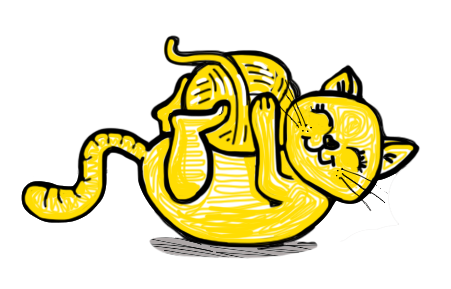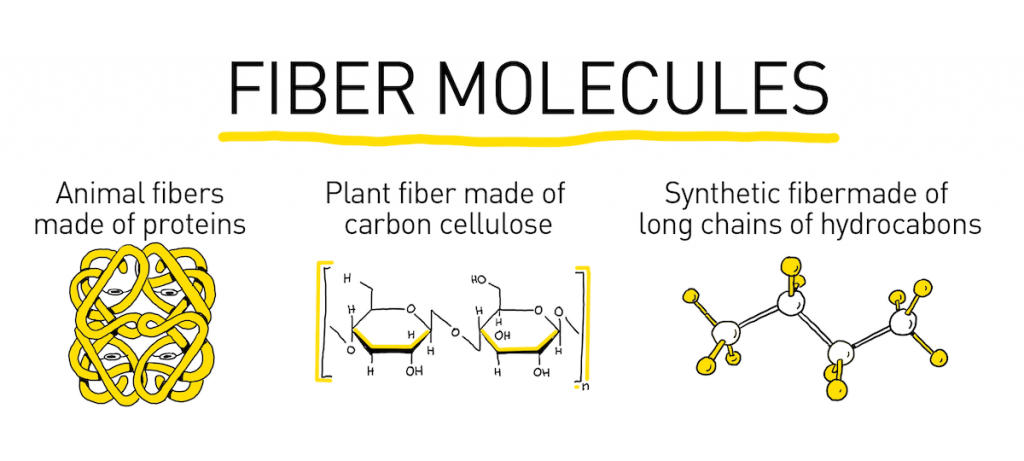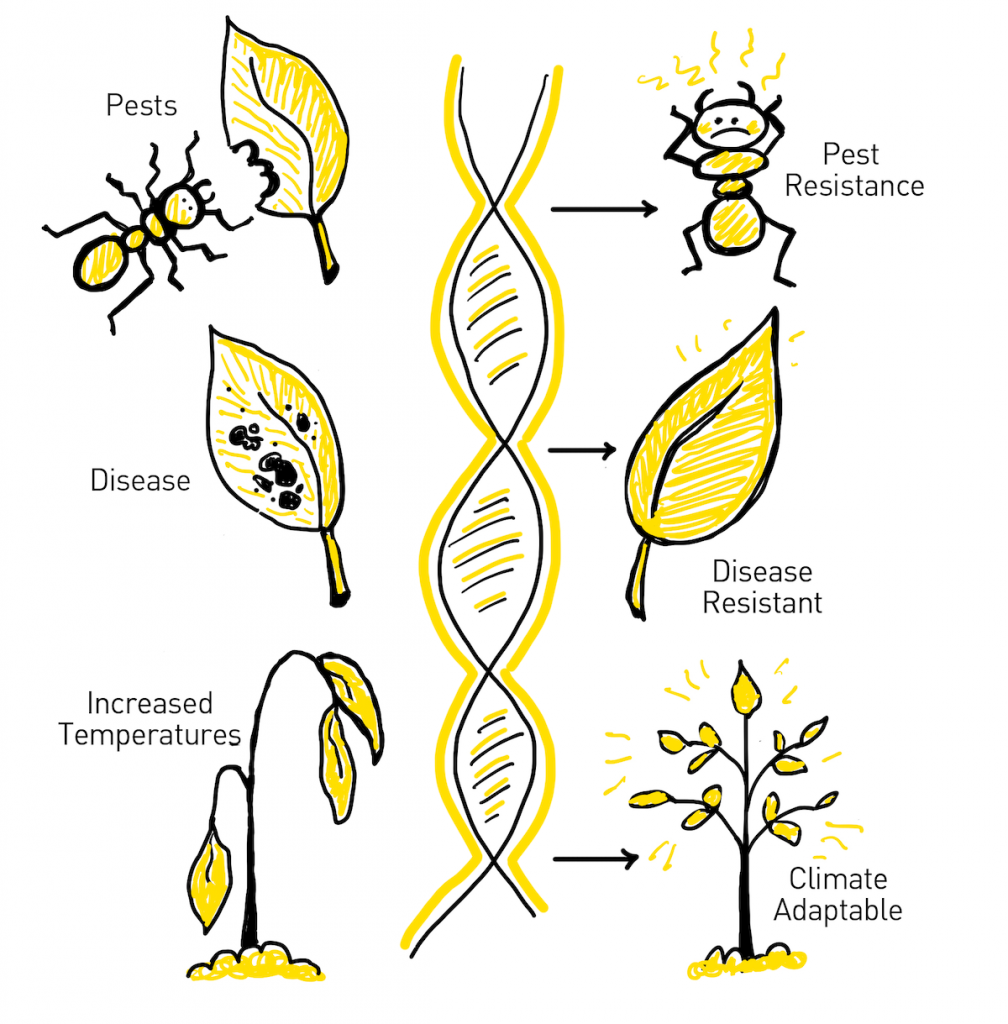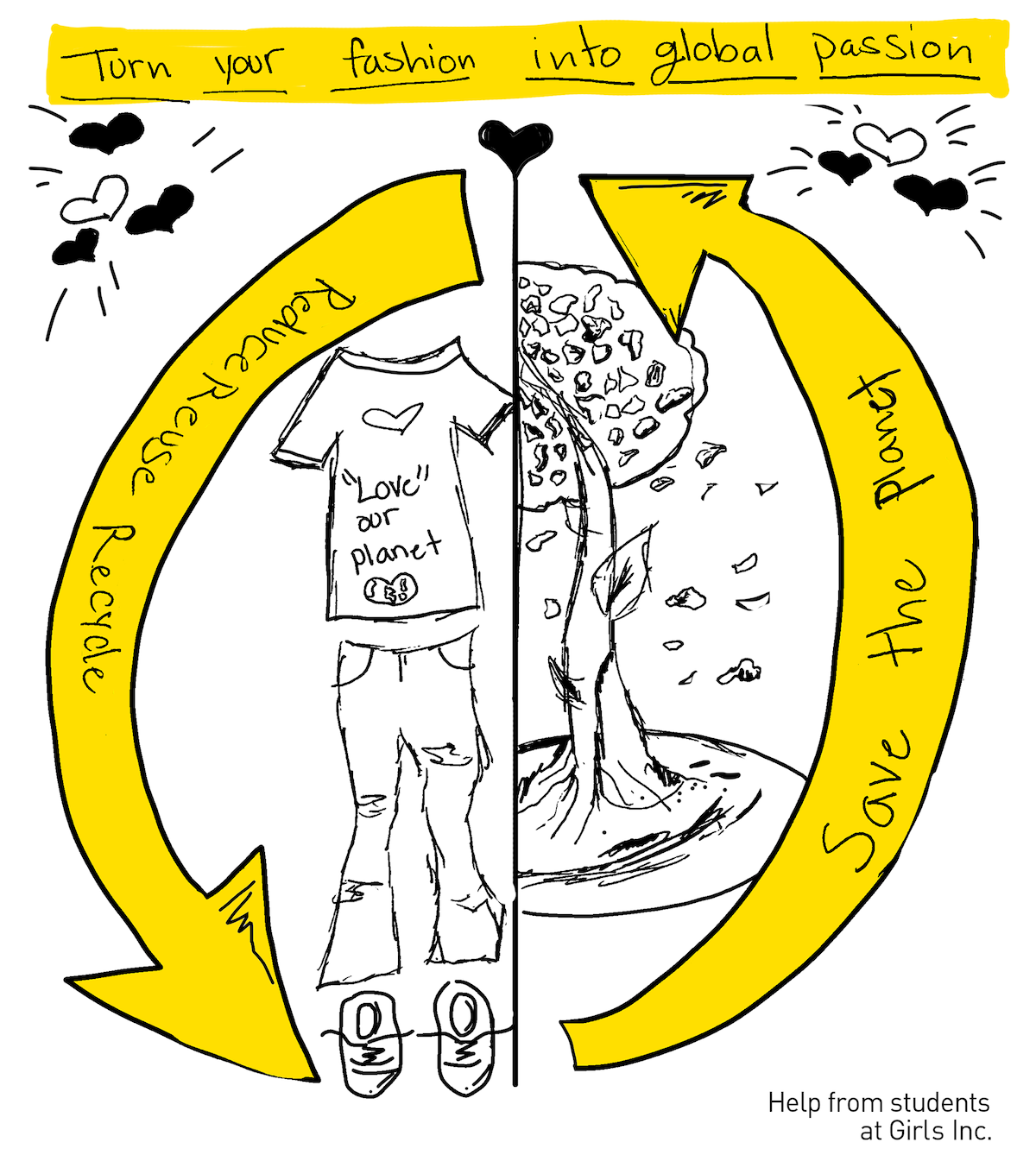An Everyday DNA blog article
Written by: Sarah Sharman, PhD
Illustrated by: Cathleen Shaw
I don’t know about you, but there is something so comforting about wrapping up in a blanket when it is cold outside or throwing on a rain jacket to head out into drizzly weather. It is part of our nature to protect our bodies from cold, rain, sunlight, and other climate or weather conditions. Early humans wrapped tree leaves, woven grasses, and tree barks around their bodies, and some relied on the skin or fur of animals. There is no evidence pointing to the exact point at which humans started wearing clothing as we recognize it today. However, some records indicate humans started wearing sewn animal skin about one million years ago.

The first material used for clothing was the natural fibers obtained from plants and animal sources. As technology advanced, synthetic fibers like polyester, nylon, and spandex were developed. While clothing made from synthetic fibers is cheaper and more durable, the processes used to make them are environmentally damaging, relying on non-renewable petroleum and harsh polluting chemicals.
Natural fibers are kinder to our environment; however, they make up only a small fraction of the fashion and clothing industries. Our growing population and changing climate put pressure on the plants that produce much of our natural fiber. There is a growing need for better, more well-adapted fiber plants. Let’s learn more about fiber plants, the products they create, and how genomics can help propel a sustainable fashion industry.
What are fiber crops?
Fiber crops play a crucial role in our daily lives, providing the raw materials necessary for producing numerous consumer goods, mainly textiles. These versatile plants, cultivated specifically for their fiber content, have been utilized for centuries, and their applications continue to evolve in modern times. Cotton, industrial hemp, flax, and jute are a few key players in the fiber crop world.
Different types of fibers are made up of different types of molecules. Animal fibers are made of proteins, while synthetic fibers are made of long chains of hydrocarbons. Fiber crops contain a high concentration of the carbohydrate cellulose, which is responsible for their strength. To be economically viable, they must produce large amounts of cellulose that can be extracted relatively easily for downstream processing. Fiber can be located in the stems (called bast fiber), leaves, or seeds of plants. Fibers can be spun into filaments, thread, or rope or matted into sheets to make paper. 
One of the most widely recognized fiber crops is cotton. This soft, fluffy fiber is obtained from the seed pods of the cotton plant, which thrives in warm climates, from the United States to India and beyond. Cotton dominates the textile industry thanks to its softness, breathability, and versatility. The fluffy fibers surrounding cotton seeds are carefully harvested and processed to become the coveted raw material for clothing, bedding, and other textile goods. The global demand for cotton continues to soar, making it a crucial crop with significant economic importance.
Flax is one of the oldest plants cultivated by humans for fiber. The earliest known evidence of flax fiber use is in the Fertile Crescent region, where it is thought flax was first domesticated. Flax fibers, derived from the slender stems of the flax plant, possess remarkable strength and flexibility. These fibers are predominantly used in the production of linen, a highly valued textile known for its coolness and elegance. Linen finds its way into various consumer goods, including clothing, tablecloths, upholstery, and even paper products. Flax cultivation predominantly occurs in cooler regions, such as Europe and Canada, where the plants thrive in temperate climates.
Hemp is yet another remarkable fiber crop with a rich history. Its use dates back to about 8,000 BC. Hemp fibers, harvested from the stem of Cannabis sativa plants, are renowned for their strength and durability, making them ideal for products such as fabrics, ropes, and even construction materials. Traditionally, hemp was widely employed in the manufacturing of ropes, canvas, and sailcloth due to its robust nature. In recent years, with increased awareness of its eco-friendly properties, hemp cultivation is gaining momentum worldwide.
Plants like palms, grasses, and pineapple plants have fibrous leaves. The fiber derived from their leaves is not very soft and is mainly used to make things like hats, handbags, and shoes. Pineapple fibers are used to make a material that looks and feels like leather. Sisal fibers from agave plant leaves can be used as a substitute for silk. 
From plant to product
Just looking at a boll of cotton or a hemp leaf, it’s hard to imagine how it becomes your favorite t-shirt or hemp purse. Sure, cotton bolls are fluffy and white, but they look nothing like the new cotton sundress I bought this summer. How do we get from the plants we recognize to the fabric we all wear and love?
For bast fiber, like hemp and flax, the fiber must be extracted from the woody stem surrounding it. Let’s focus on hemp and walk through the process from plant to product. Once the hemp plants mature, they are harvested by cutting them close to the ground. The plants are left to dry in the field or moved to a drying facility. After drying, the hemp stalks undergo a process called retting. Retting helps separate the long fibers from the woody core of the stalk. There are different retting methods, but one common approach is to soak the stalks in water to allow natural bacteria and microorganisms to break down the pectin, which holds the fibers together.
Next, the stems are broken into smaller pieces and beaten to separate the fibers from the woody core. The fibers are then combed to remove any remaining woody particles, twisted to improve strength, and wound onto a spinning bobbin. Finally, the fibers are spun into yarn using wet or dry spinning.
Although seed fiber, like cotton and milkweed, does not have the problem of being contained in a woody stem like bast fiber, it does have the complication of surrounding a seed. The valuable fiber must be removed from the seed. To learn more about the process from cotton boll to t-shirt, read “Cotton genetics: creating softer, more sustainable cotton.”
Will our changing climate be the end of fashion? Not if genomics can help it.
I’ve just described the many types of fiber that we rely on for textiles and other valuable consumer goods. You may be thinking we’re all set because we have so many sources of fiber. Unfortunately, that is not the case. Mother Nature often makes it difficult for farmers to keep up with supply and demand. Many pests and diseases threaten fiber crops. Additionally, changing weather patterns and increasing temperatures put pressure on fiber crops. Many fiber crops grow well in certain regions but struggle to adapt to new locations, temperatures, or climates. 
Scientists at the HudsonAlpha Institute for Biotechnology know how to explore plants’ DNA to determine which parts give the plants certain traits, like drought tolerance, disease resistance, or the ability to adapt to new temperatures. This type of genetic understanding can help plant breeders introduce beneficial traits into crop plants and create more resilient, adaptable plants.
Cotton requires many inputs like fungicides, pesticides, fertilizers, and irrigation systems to thrive. Scientists at the HudsonAlpha Genome Sequencing Center have long sought to improve cotton using genomics. They sequenced the first cotton genome in 2012 and over a dozen more since then. As a species, cotton does not have much genetic diversity, limiting the ability of scientists and breeders to use traditional breeding to improve cotton. The GSC team is currently creating a cotton pangenome, a collection of many cotton genomes. This tool will allow researchers to more accurately find genetic targets to introduce beneficial traits into different cotton species.
Improving hemp as a fiber source is complicated because only female plants produce fiber and other important products like oil and protein. Traditional breeding methods yield roughly half males and half females. Faculty Investigator Alex Harkess, PhD, is studying hemp DNA to find areas of the genome involved in important traits like drought tolerance and determine what genes make male and female plants. By identifying the gene or genes that make hemp female, scientists in the Harkess lab can help hemp breeders and farmers produce more female plants. Breeding more female hemp plants will increase the yield and quality of hemp fiber, making it a sustainable and valuable crop for farmers and consumers.
This summer, I had the privilege of spending an hour with a few young ladies participating in the Girls, Inc. Eureka! STEM Achievement Program. We chatted about science communications as a career option. Then the girls helped me with this blog article. We brainstormed a title and subtitles, talked about important facts to include in the article, and they even helped me think up illustration ideas. The image below is one of the illustrations a student named Mea designed based on the idea that sustainable fibers can help make the fashion industry more eco-friendly.
Contributions by: Girls, Inc. participants (Makayla W., Kaitlyn W., Angel J., Lela L., Mea, Hylis H.)



